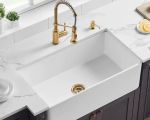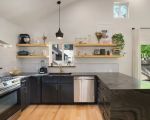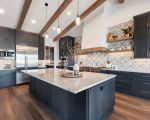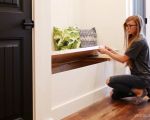Best Flooring Options for Bathrooms and Kitchens
When it comes to remodeling or upgrading your home, choosing the right flooring for bathrooms and kitchens can be an overwhelming decision. I’ve gone through my fair share of flooring choices, and trust me, the process can be complicated. But once you understand the benefits of each type, it becomes much easier to decide. In this guide, I’ll walk you through the best flooring options available for these high-traffic, moisture-prone areas and share some personal insights on each. By the end, you’ll have a much clearer idea of which option suits your space, lifestyle, and budget the best.
1. Ceramic and Porcelain Tiles
When I first remodeled my kitchen, I was looking for something durable and water-resistant. Ceramic and porcelain tiles immediately caught my eye, and after using them, I can confidently say they are a fantastic choice for both bathrooms and kitchens.
Tiles come in a wide variety of sizes, colors, and designs, which means you can customize them to match any style. For instance, I went with large, light-colored tiles to make my kitchen appear more spacious, and the result was stunning. These tiles are also incredibly easy to clean, which is a major advantage in high-moisture environments like kitchens and bathrooms.
Another reason I love ceramic and porcelain tiles is their longevity. They’re resistant to scratches, stains, and water, which means they’ll stand the test of time, even in high-traffic areas. One thing to keep in mind, though, is that grout lines can sometimes be tricky to maintain, so consider opting for larger tiles to minimize grout spaces.
2. Vinyl Flooring
If you're on a budget but still want a stylish, durable option for your bathroom or kitchen, vinyl flooring is an excellent choice. I used vinyl planks in my bathroom, and I was amazed by how affordable and practical they were.
Vinyl flooring has come a long way in terms of quality. It’s available in sheets, tiles, and planks, and it’s known for being incredibly versatile. What’s great about vinyl is that it can mimic the appearance of more expensive materials like wood or stone, but at a fraction of the price. Plus, it’s water-resistant, making it ideal for bathrooms and kitchens.
The comfort of vinyl is another selling point. Unlike ceramic tiles, which can feel cold underfoot, vinyl provides a softer and warmer surface, which is especially nice during the winter months. In terms of maintenance, it’s easy to clean, and it resists staining, so spills in the kitchen are no problem.
3. Natural Stone Flooring
Natural stone floors like granite, slate, or marble are luxurious options for kitchens and bathrooms. However, I’ll be honest, this option is not for everyone. When I installed a marble countertop in my kitchen, I fell in love with the elegance it brought to the space, and I began considering natural stone flooring. While it adds a sophisticated touch, it does come with some maintenance considerations.
Stone floors are beautiful, and they can elevate any room, but they do require sealing to prevent stains and damage from water. Additionally, natural stone can be prone to scratching, especially in the kitchen where you might have pots and pans constantly in motion. Despite this, if you’re willing to put in the time to care for it, stone flooring will reward you with a timeless, beautiful look that other materials can’t match.
4. Laminate Flooring
When I was looking for an affordable flooring option for my rental property, laminate flooring was the way to go. It offers a wide variety of designs, including options that mimic hardwood and tile, which is perfect if you want the look of wood without the high maintenance.
Laminate flooring is durable and water-resistant, which makes it suitable for kitchens and bathrooms. What impressed me most was how easy it was to install—no professional installation required! It’s also easy to clean and maintain, and the price point is lower than many other flooring options.
However, laminate isn’t as resilient as ceramic or porcelain tiles. While it’s water-resistant, it’s not fully waterproof, so spills should be cleaned up promptly. The seams of laminate flooring can also warp over time if exposed to excessive moisture.
5. Cork Flooring
I never considered cork for my kitchen or bathroom until I did some research, and now I think it’s a fantastic option, especially for those who want something eco-friendly. Cork is made from the bark of cork oak trees, and it’s a renewable resource. It’s also naturally resistant to mold and mildew, making it a great option for moisture-prone areas.
One of the standout features of cork flooring is its comfort. It’s soft and cushioned underfoot, which can make a big difference if you spend a lot of time cooking or cleaning. I’ve heard from several people who installed cork in their kitchens, and they’ve found it to be a warm, inviting choice. The only downside is that cork can be more susceptible to dents and scratches, especially in high-traffic areas.
6. Concrete Flooring
If you're after a more modern, industrial look, then concrete might be the perfect flooring for you. While I initially hesitated to go with concrete due to its cold, hard surface, I quickly realized that it was highly durable and offered an incredible range of design options.
Concrete flooring can be stained or polished to create a unique, customized look. It’s incredibly durable and resistant to water, stains, and scratches. It's also easy to clean—just sweep or mop, and it’s good to go. One downside, however, is that concrete can feel cold and hard underfoot, which can be uncomfortable, especially during the winter months. To combat this, consider installing radiant floor heating if you go with concrete flooring.
7. Engineered Hardwood Flooring
Engineered hardwood is another flooring option that has been gaining popularity for kitchens and bathrooms. I was initially skeptical about using hardwood in these areas, but engineered hardwood has made it possible to enjoy the beauty of wood without worrying about warping or water damage.
What makes engineered hardwood different from traditional hardwood is that it’s constructed with multiple layers of wood, making it more stable and resistant to moisture. It still provides the beautiful look of natural wood, but it won’t expand or contract as much in humid or wet environments. That said, it’s not completely waterproof, so it’s still important to clean up spills quickly.
8. Rubber Flooring
Rubber flooring is a relatively new option for kitchens and bathrooms, but it has a lot of appeal. It’s durable, water-resistant, and slip-resistant, making it a great choice for safety-conscious homeowners. When I installed rubber flooring in my home gym, I immediately noticed how comfortable and easy it was to stand on, and it didn’t take long to realize that it could be a great option for kitchens and bathrooms too.
Rubber flooring is often found in tiles or rolls, and it’s available in a wide range of colors and textures. It’s easy to install and maintain, and it’s resistant to bacteria, which is an added bonus in moisture-heavy areas. The downside is that it may not provide the high-end aesthetic that some people want in their kitchens or bathrooms. However, if you prioritize functionality and comfort, rubber flooring is an excellent option.
Which Flooring Should You Choose?
When I was choosing flooring for my kitchen and bathroom, I had a lot of things to consider. Budget, durability, maintenance, and aesthetics all played a part in my decision. The best flooring for you ultimately depends on your personal preferences and how much time you're willing to dedicate to upkeep. Some people prioritize ease of maintenance and low cost, while others focus on aesthetics or eco-friendly options. Whatever you choose, make sure it’s something that will fit with your lifestyle and the demands of these high-traffic, moisture-prone spaces.
Remember, there’s no one-size-fits-all solution. Whether you opt for the timeless elegance of stone, the comfort of cork, or the budget-friendly appeal of vinyl, your floor should reflect your style and be practical enough for everyday use. Hopefully, this guide has helped you better understand the options available and narrowed down your choices for your next home improvement project.
For more advice on home improvement projects and the best products for your needs, make sure to visit our website for personalized recommendations.








